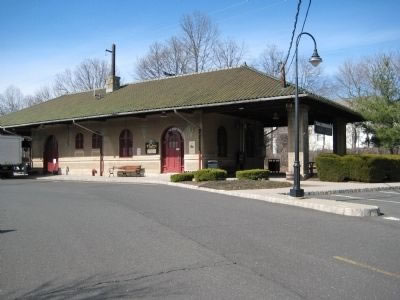Far Hills CCTV & Security Cameras
The Borough of Far Hills in the Somerset Hills of New Jersey was set off from Bernards Township and incorporated as a political entity in 1921 by means of a special act of the New Jersey Legislature and a successful local referendum in which 117 votes were cast in favor of forming a borough and 15 votes were in opposition.

The new, five square mile municipality had about 200 residents and was possessed of spectacular terrain and geological formations. The rift valley of the Ramapo Fault transected the borough, separating the Jersey Highlands and the gorge of the North Branch of the Raritan River from the foothills of the Second Watchung Mountain.
The fractured basalt columns on 1-287 near Layton Road, where ice freezes on the rocks, are a visible outcropping of the lava flows, which formed the Watchung Mountains 160 million years ago. Moggy Hollow, near Liberty Corner Road, once was the outlet for Glacial Lake Passaic, a gap through which water spilled down into the alluvial valley below.
The Peapack path, an ancient Indian trail, followed the course of the North Branch and was traversed by tribes of the Lenni Lenape in their migrations from the northwest mountains to the Jersey shore. Indian tools and points have been retrieved from sites near Mine Brook and the Raritan River.
When the English succeeded the Dutch as owners of the American colonies, the lands that later became Far Hills were patented by the Proprietors of East New Jersey to William Penn and his associates and to Donald Danielson Dunstar and James Alexander, the father of Lord Stirling.
Early settlers leased and later purchased land. Among them were the Comptons, Dumonts, Frosts, Laytons, Limis, Whitenacks and Wyckoffs who farmed the upland meadows and the bottom lands along the river. Millers employed the water power of the streams for industrial use. Zachariah Smith built a saw mill and brush block factory on the North Branch shortly after 1800. Eighty years later it was still in operation under his grandson, Oscar Smith.
Further south on the river, in the area known as Forge Hollow and later as Hub Hollow, William Ludlow was a shoemaker and his son, Charles, had a saw mill and woolen factory which were succeeded by the Ludlow Family's hub factory.
The fractured basalt columns on 1-287 near Layton Road, where ice freezes on the rocks, are a visible outcropping of the lava flows, which formed the Watchung Mountains 160 million years ago. Moggy Hollow, near Liberty Corner Road, once was the outlet for Glacial Lake Passaic, a gap through which water spilled down into the alluvial valley below.
The Peapack path, an ancient Indian trail, followed the course of the North Branch and was traversed by tribes of the Lenni Lenape in their migrations from the northwest mountains to the Jersey shore. Indian tools and points have been retrieved from sites near Mine Brook and the Raritan River.
When the English succeeded the Dutch as owners of the American colonies, the lands that later became Far Hills were patented by the Proprietors of East New Jersey to William Penn and his associates and to Donald Danielson Dunstar and James Alexander, the father of Lord Stirling.
Early settlers leased and later purchased land. Among them were the Comptons, Dumonts, Frosts, Laytons, Limis, Whitenacks and Wyckoffs who farmed the upland meadows and the bottom lands along the river. Millers employed the water power of the streams for industrial use. Zachariah Smith built a saw mill and brush block factory on the North Branch shortly after 1800. Eighty years later it was still in operation under his grandson, Oscar Smith.
Further south on the river, in the area known as Forge Hollow and later as Hub Hollow, William Ludlow was a shoemaker and his son, Charles, had a saw mill and woolen factory which were succeeded by the Ludlow Family's hub factory.
Box Camera Specifications
|
Geovision HD-SDI Varifocal Box Camera
|

